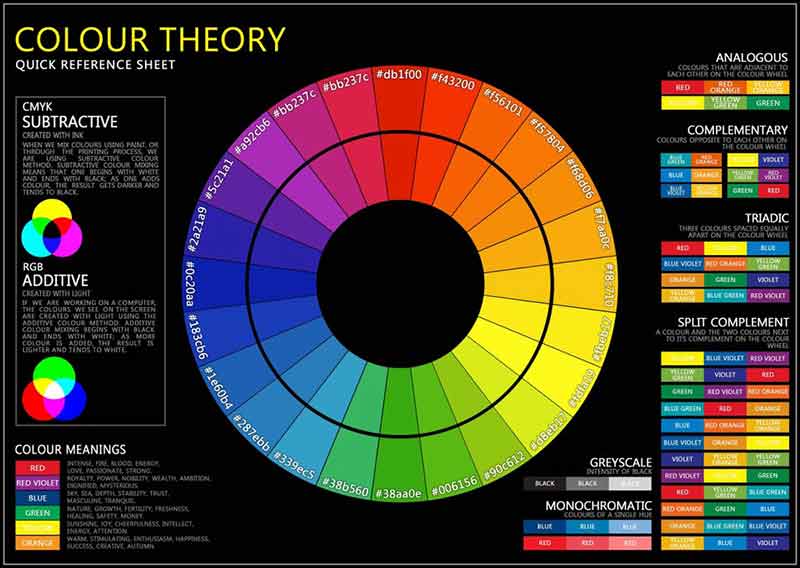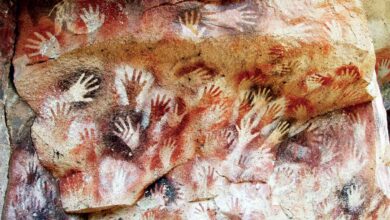History of Color

From time immemorial, man has been the clear blue of the sky, the bright red and orange at sunset, the soft and variable colors of the rainbow that symbolize the hopes of heaven, the faint and unstable light that shines from the peacock’s proboscis.
The colorful clothes of flowers, browns and golden reds of autumn leaves that are very different from the green colors of the previous spring. The bright red and threatening eruption of blood, the yellow flicker of the tallow flame that painted the shadows of impatient statues on the deep walls of the caves should have seen a lot of surprise, joy and astonishment, but all these colors are single notes Of all the vibrating notes, they are a provocative symphony of color in human life.
It did not take long for human beings to try to adapt to this mysterious and mysterious symphony called color. Bones (cylindrical in shape) have been discovered — perhaps between 150,000 and 200,000 years ago — in which humans made GRAEASE PAINTS from red, yellow, and ocher clays. And used to decorate and adorn his body, primitive man naturally gave himself reason that red matter is life-giving. So the people of the last ice age (100,000 years ago) in the past buried themselves under the red soils of the last days, or rubbed red on their bones, thus beginning a tradition in Europe that lasted for thousands of years. And even spread to Africa and Asia. In 1823, for example, the skeleton of a young man was discovered in Rels LADY OF PAYILAND. Similar artifacts have been found in caves in South Africa and China.
Calorie meters and color science
COLORIMETRY is a color measurement technique, but it is only part of the science of color. Color science includes all the knowledge and information related to the production of color stimuli and their visual perception. Color science includes parts of physics, chemistry, biology and psychology. Calorimetry also uses parts of the above sciences, especially physics and psychology.
Calorie meter is based on the idea that a relationship can be found between the physical properties of the color stimulus and the resulting perceptual insight. Newton discovered that there are many types of visible radiant energy, and that white light is just one of the visible aspects of the mixing of these types, which is received from the sun or similar sources. Differences between types of radiant energy are determined by their wavelengths (WAVE LENGTHS). To define wavelengths well, we need to explain how to measure them. But suffice it to say here that visible radiant energy is limited to wavelengths in the range of 380 to 760 millionths of a millimeter (or millimicrons). The following is the range of wavelengths and related colors.
Purple 380-450 microns
Blue 450 – 490
Green 490 – 560
Yellow 560 – 590
Orange 590 – 630
Red 630 – 760
Newton concluded that when objects appear in color when there is one or at most two types of radiant energy reflected in the radiant energies reflected in the human eye, he noted that most temporal objects It appears in color that “obstructs the passage” of some of the radiated energy and reflects the rest. Today, the word ABSORPTION is used instead of the word “passage barrier”.
The necessity of radiant energy, the variety and number of these types of energies, and the passive role of objects that affect color vision are the most important issues in which physics has contributed to color science. Methods for measuring and controlling the type and amount of radiant energy have been greatly improved by the characteristics of reflection and transmission of light by objects by physicists and chemists, but the principles are the same as Newton clearly described.
Because visible radiant energy is required to perceive color, and in addition because only aspects that the observer is aware of can be the criterion, they define color as a definite characteristic of light. Some irrelevant light characteristics such as DIRECTION and FLICKER are excluded. But they consider all the characteristics of light that are able to distinguish one type from another as part of the color of light.
The definition of color in terms of light, which is itself a psycho-real science, also introduces color as a psycho-real process. Color measurement methods use the judgments of human observers directly or standard digit information based on indirect human judgments. Therefore, the complete and used definition of color is in complete agreement with its definition in terms of light, and makes color calorimetric a psycho-real process. This definition may differ from other people’s definitions. One person may think of color as an perception, while another may define color as an object that absorbs different wavelengths in different proportions.
The characteristics of light that make up the color entity as defined can be defined into multiple and usable titles, but perhaps the simplest and most comprehensible characteristics of light are LUMINANCE, DOMINANT WAVE LENGTH ) And PURITY. Brightness is the characteristic that distinguishes between the light reflected from the white paper of this screen, when illuminated by a 100-watt lamp and when illuminated by a 200-watt lamp. The idea of the original wavelength can be said to be the wavelength at which the corresponding light appears to be the original. The main wavelength does not have to be the wavelength that is physically the strongest radiant energy in the stimulus, although it is usually close to this physical maximum.
Likewise, it can be said that purity is the degree of dominance, protrusion, and majority of the original wavelength in the desired light. Purity, like the original wavelength, cannot be obtained directly from physical stimulus measurements. For more accurate definitions of brightness, principal wavelength and purity, their measurement methods should be described. In addition, these methods are essential for complete definitions of comprehensive ideas of light and color. Definitions based on measurement methods are called OPERATIONAL DEFINITIONS. Practical definitions of color light, brightness, principal wavelength and purity are all the basis of calorimetry.
Hue is a quality of perception by which an observer is aware of differences in the wavelengths of radiant energy. SATURATION is a quality of perception by which an observer is aware of the differences between the net for each major wavelength. However, it should be noted that equal purities from different main wavelengths do not necessarily lead to the perception of equal saturation. BRIGHTNESS is a term commonly used for a quality of perception by which an observer is aware of the differences between brightness.
History and industrial production of dyes
Prehistoric man dyed leather, textiles, and other objects with natural materials, mostly plant-based but some of which were of animal origin. Ancient Egyptian inscriptions provide a complete description of how dyes are extracted from their natural sources, as well as their application in dyeing operations.
Subsequent developments over a period of more than several thousand years resulted in complex dyeing processes and high-quality dyed goods, among which the following materials are not worth mentioning. INDIGO, derived from both European-specific dyers and INDIGO FERA TINCTORIA, an indigenous Asian tree. ANCIENT PURPLE was obtained from a purple snail gland by a process discovered by the Phoenicians. ALIZARIN, which forms the basis of the Turkish red (TURKEY RED), was obtained from MADDER CARPEDOCHI timber imported from Africa.
PICRIC ACID, obtained by WOULFE in 1771 by indigo reaction with nitric acid, was later sometimes used for dyeing silk, but was not very important, so it really Error Production of the first synthesized organic dye to be given to William Hash Preiken instead of Wolfe. In 1856, this young and intelligent English chemist working around London on the oxidation of a mixture of aniline bases succeeded in replacing QUININE, which he had hoped to find, with a purple cationic dye called MAUVEINE – and in the beginning The percentage of solution was very low. It is correct to mention Perkin as the founder of the synthesized dyeing industry in several ways, because on the one hand he was able to produce relatively pure and technically significant products with the basic facilities available, and on the other hand he synthesized his own. It was developed in such a way that it was possible to produce it on an industrial scale.
The bright purple hue that this dye produced on silk immediately attracted special attention and motivated other chemists to perform similar experiments. Thus, in 1859, VERGUIN in Leon discovered FUSHINE, while the discovery of diazo compounds by GRIESS in the United Kingdom formed the basis for the development of the largest group of synthesized dyes, now called AZO COMPOUNDS. Are called provided. The first real dye called BISMARK BROWN was made in 1863 by MARTIUS.
After extensive and decisive AUGUST VON KEKULE research on the quadruple carbon capacity in 1858 and the benzene structure in 1865, the way was opened for the planned production of fully synthesized dyes in addition to the synthesis of natural dyes. The first notable success was the understanding of the chemical structure (in 1868) and then the immediate synthesis of alizarin (25-dihydroxy anthraquinone) by Gribb and Lieberman. (GRAEBE AND LIEBERMAN) Understand the chemical structure and synthesis of indigo. (VON BAEYER ADOLF) In 1870, K. HEUMANN undertook decades of research. The development of Indigo dyes reached its peak at the beginning of the twentieth century as a result of the work of G.ENGI and P. FRIEDLANDER, who synthesized CIBA BLUE 4B and THIO INDIGO, respectively. Shortly before the turn of the century, VIDAL paved the way for sulfur dyeing, while 1901 marked the discovery of INDANTHRONE, the first ANTHRA QUINONNOID VAT DYE by Ben (R.BOHN).
Early natural dyes even included metal complexes (Turkish red). In this regard, the twentieth century introduced valuable developments in the form of NEOLAN DYES in 1915, PHTHALOCY ANINE in 1936, and 1: 2 metal complex dyes (IRGALAN DYES) in 1949. R.CLAVEL AND H.DREYFUS solved the dyeing of hydrophobic fibers by dispersion dyes in the 1920s.
Post-World War II era with the production and development of pigments (PIGMENTS) that are of great importance in the field of plastic dyeing, such as QUINACRIDONE in 1958 REACTIVE DYES for wool, such as Remalen dye (REMALAN) and CIBALAN in 1952-1951 [and especially reactive dyes for cellulosic fibers (eg PROCION DAYES) Marked New developments and developments in this field by Fitzner (H.PHITZNER) ] 2 [(K.VENKATARAMAN)] 3 [have been reviewed.
Reactive dyes, for example, clearly show that dye research has moved away from the synthesis of dye molecules quite empirically and has turned to investigating the mechanism of combining dyes with chromogens such as AZO anthraquinone (CYCLICAZA). , CANTHRACOUINONE) COMPOUNDS is available.
Colorindex
Although dyes can be classified in at least several possible ways, for each of which there is a criterion for distinguishing between dyes and dyes, in the present discussion the set used in standard works for dyes and dyes Is followed and this collection is called COLOR INDEX (SDC AND AATCC 1956,1963). This five-volume color list, which consists of 4275 pages, should have been named as COLOR INDEX. .
In the COLOR INDEX, dyes are classified according to their method of use and are identified by an application number, for example (CIVAT REDB) or (CIDISPERSE BLUE1), since Calrindex users usually refer to the functional properties of dyes. They are interested, so this type of classification is very useful and is very similar to the classification used in the first edition of the Calrindex (1928-1928) and the old German edition of this type (SCHULTZ 1931).
A review of the calrindex shows that the same chemical compounds often prevail in a particular category or classification based on functional properties.
Because there is no century-old relationship between the type of chemical and its method of application. Thus, Calrindex may list the exact same chemical in several classes in terms of its functional properties, provided that the chemical is widely used in each of these classes. An example of this is C.I. VAT VAT BLUE 14, which is also widely used as a colorant and is therefore listed under C.I.PIGMENT BLUE 22. In addition, a color index is assigned to the chemical structure of each dye in cases where the building is known (the chemical nature of many dyes is a commercial prohibition). This number is used without considering the color class of the dye, so the use of Calrindex for the dyes mentioned above is: C.I.VAT BLUE14, COLOR INDEX 69810
C.I.PIGMENT BLUE 22. COLOR INDEX 69810
Another case in which the same chemical compounds can be named as a dye or dye is as follows. In the examples shown below except the Azoic couple
(AZOIC COUPLING COMPONENT 1) can be combined with AZOIC DIAZZO COMPONENT 37 on the fiber. The resulting compound has a color index number. When the same components are combined and the resulting product is separated into a dry powder, it is named (C.I.PIGMENT RED No.1), which is also known as (PARA RED). In the same way (PERMANENT CARMENE) can be made either on paper or in powder form. The compounds on the fiber are called naphthalene dye and the product in powder form is called dye.
Calrindex lists 17 classes of dyes, or approximately 5,000 dyes by application (in addition, there are thousands of other possible combinations, of which 400 to 500 dyes are in use), but only one category of dyes with about 400 dyes is listed. Has been.
This general difference shows that the dye method is very important for the consumer. Pigments are always used by an adhesive that acts as an intermediary between the dye and the substrate on which it is placed. Changing the type of adhesive allows considerable flexibility in the use of pigments for different backgrounds, and as a result requires a relatively small number of pigments for the many and varied blends of pigments, adhesives, and substrates used today. we have. However, the large number of fibers as well as the dyeing conditions that are used today require different chemical properties and in addition to a great variety of color effects, and therefore, in practice, a relatively higher number of dyeing materials are needed.
Dyes that are classified based on the materials used in the Calrindex It should be noted that all dyes fall into only one functional group.
Acidic-Toothed Dyes-Bacteria-Disperses-Natural-Food-Leather-Straight-Sulfur-Bent-Ingrin-Azoic-Oxidation-Reactive-Solvent-Fluorescent Brightening Agents-Appearances-Reducing Agents.
Dyes and dyes that are synthesized in organic compounds and are also important can be classified either in terms of chemical structure and in terms of their end uses. Classification This section was classified according to their chemical composition because this is the most appropriate way to consider the preparation of these materials. More than twenty different and different chemical compounds have been used as synthetic dyes. But only five of them are mainly considered, which are:
This study will also focus on this classification.
* Sources and references are available in the editorial office of Artmag.









